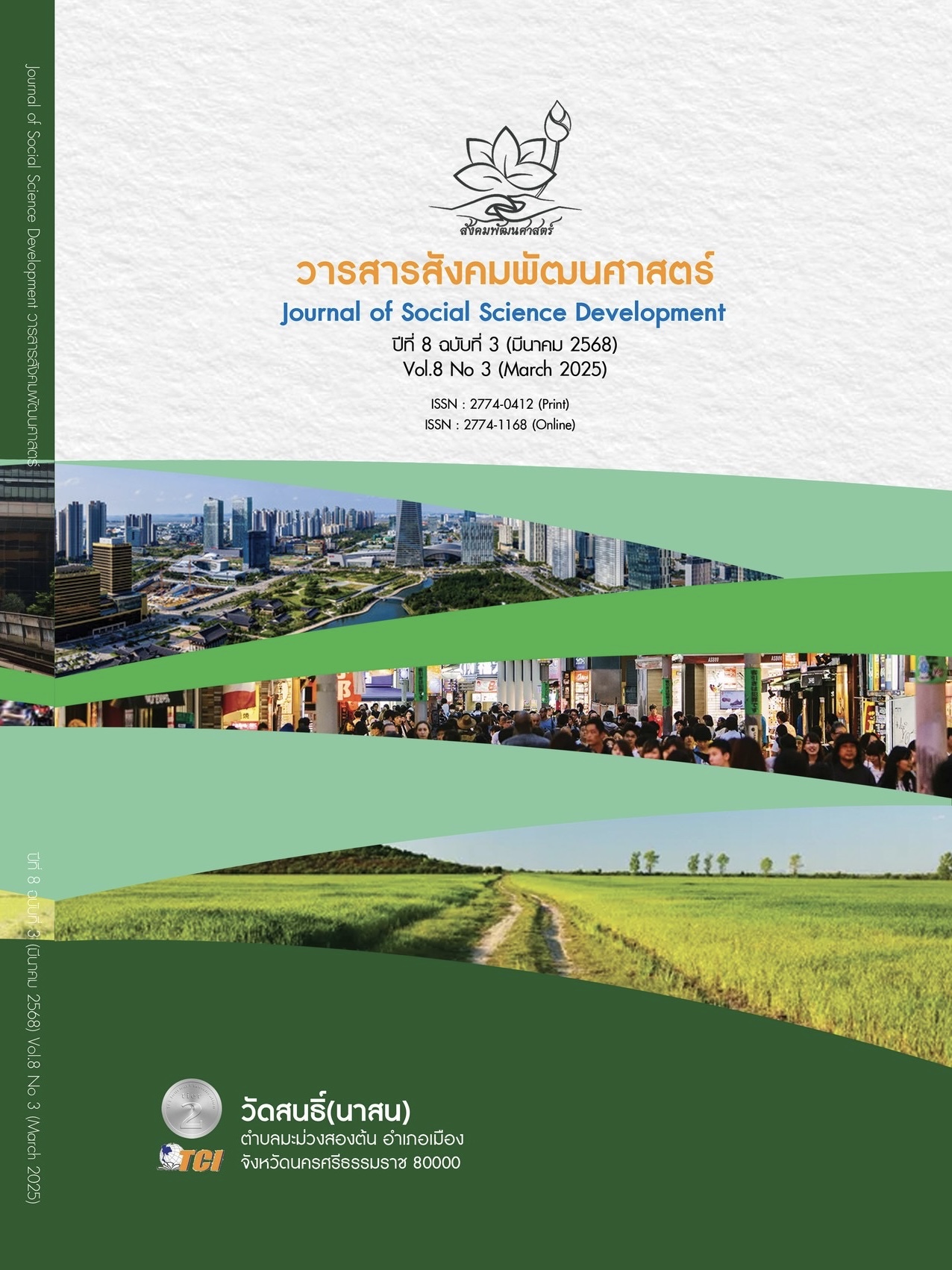คุณภาพชีวิตด้านจิตใจของผู้ป่วยโรคกล้ามเนื้ออ่อนแรงจากพันธุกรรม
Main Article Content
บทคัดย่อ
การวิจัยนี้เป็นการวิจัยเชิงคุณภาพ ตามแนวปรากฏการณ์วิทยา มีวัตถุประสงค์เพื่อศึกษาคุณภาพชีวิตด้านจิตใจของผู้ป่วยโรคกล้ามเนื้ออ่อนแรงจากพันธุกรรม ซึ่งเป็นผู้ป่วยในกลุ่มโรคที่หายากจึงขาดข้อมูลและความเข้าใจเชิงลึกในหลายมิติ การศึกษาเริ่มต้นจากกรอบแนวคิดคุณภาพชีวิตด้านจิตใจขององค์การอนามัยโลก และแนวคิดคุณภาพชีวิตของคนพิการ ผู้ให้ข้อมูลหลักในการวิจัย คือ ผู้ป่วยโรคกล้ามเนื้ออ่อนแรงจากพันธุกรรมและผู้ดูแลหลักรวม 7 คน การเลือกผู้ให้ข้อมูลหลักเป็นแบบเฉพาะเจาะจง โดยคัดเลือกผู้ป่วยที่มีอาการรุนแรงจนกล้ามเนื้อเสื่อมสภาพและส่งผลต่อการเคลื่อนไหว ซึ่งได้รับการแนะนำมาจากผู้ที่รู้จักใกล้ชิดกับผู้ป่วยและผู้ดูแลได้รับการเสนอชื่อโดยผู้ป่วย เครื่องมือหลักที่ใช้ในการวิจัยคือแนวคำถามแบบกึ่งโครงสร้างซึ่งเป็นคำถามแบบปลายเปิด เก็บข้อมูลโดยการสัมภาษณ์เชิงลึกและใช้การวิเคราะห์เนื้อหาในการวิเคราะห์ข้อมูล ผลการวิจัย สรุปคุณภาพชีวิตด้านจิตใจของผู้ป่วยโรคกล้ามเนื้ออ่อนแรงใน 5 ประเด็น คือ 1) ผลกระทบทางด้านจิตใจจากความเจ็บป่วย 2) การยอมรับความเจ็บป่วยและความพิการ 3) ความเข้มแข็งที่มาจากความรัก กำลังใจ และหลักยึดเหนี่ยวทางใจ 4) มุมมองเชิงบวกต่อชีวิตและการมุ่งมั่นจะพึ่งตนเอง และ 5) การสนับสนุนจากครอบครัวและเครือข่ายทางสังคม ผลการศึกษาทำให้นักจิตวิทยาและผู้ที่ทำงานเกี่ยวข้องได้เข้าใจคุณภาพชีวิตด้านจิตใจของผู้ป่วย และนำไปใช้ประโยชน์ในการดูแลช่วยเหลือผู้ป่วยโรคกล้ามเนื้ออ่อนแรงต่อไป ข้อเสนอแนะ ให้มีการพัฒนาระบบอาสาสมัคร มีการดูแลแบบการจัดการรายกรณี การให้คำปรึกษาเชิงจิตวิทยาที่สนับสนุนให้เกิดการยอมรับตนเองและยอมรับอุปกรณ์เครื่องช่วยในชีวิตประจำวัน
Article Details

This work is licensed under a Creative Commons Attribution-NonCommercial-NoDerivatives 4.0 International License.
References
คณะกรรมการส่งเสริมและพัฒนาคุณภาพชีวิตคนพิการแห่งชาติ. (2560). แผนพัฒนาคุณภาพชีวิตคนพิการแห่งชาติ ฉบับที่ 5 พ.ศ. 2560 - 2564. กรมส่งเสริมและพัฒนาคุณภาพชีวิตคนพิการ. กรุงเทพมหานคร: กระทรวงการพัฒนาสังคมและความมั่นคงของมนุษย์.
ชาย โพธิสิตา. (2562). ศาสตร์และศิลป์แห่งการวิจัยเชิงคุณภาพ. (พิมพ์ครั้งที่ 8). กรุงเทพมหานคร: สำนักพิมพ์จุฬาลงกรณ์มหาวิทยาลัย.
เบญจา ยอดดำเนิน-แอ็ตติกจ์ และกาญจนา ตั้งชลทิพย์. (2552). การวิเคราะห์ข้อมูลเชิงคุณภาพ: การจัดการข้อมูล การตีความ และการหาความหมาย. (พิมพ์ครั้งที่ 1). นครปฐม: สถาบันวิจัยประชากรและสังคม มหาวิทยาลัยมหิดล.
ผู้ให้ข้อมูล คนที่ 1. (29 มี.ค. 2565). คุณภาพชีวิตด้านจิตใจของผู้ป่วยโรคกล้ามเนื้ออ่อนแรงจากพันธุกรรม. (ณัฐกา สงวนวงษ์, ผู้สัมภาษณ์)
ผู้ให้ข้อมูล คนที่ 2. (19 พ.ค. 2565). คุณภาพชีวิตด้านจิตใจของผู้ป่วยโรคกล้ามเนื้ออ่อนแรงจากพันธุกรรม. (ณัฐกา สงวนวงษ์ และอรอนงค์ สงเจริญ, ผู้สัมภาษณ์)
ผู้ให้ข้อมูล คนที่ 3. (6 มิ.ย. 2565). คุณภาพชีวิตด้านจิตใจของผู้ป่วยโรคกล้ามเนื้ออ่อนแรงจากพันธุกรรม. (ณัฐกา สงวนวงษ์ และอรอนงค์ สงเจริญ, ผู้สัมภาษณ์)
ผู้ให้ข้อมูล คนที่ 4. (4 พ.ย. 2565). คุณภาพชีวิตด้านจิตใจของผู้ป่วยโรคกล้ามเนื้ออ่อนแรงจากพันธุกรรม. (ณัฐกา สงวนวงษ์ และอรอนงค์ สงเจริญ, ผู้สัมภาษณ์)
ผู้ให้ข้อมูล คนที่ 5. (30 มี.ค. 2565). คุณภาพชีวิตด้านจิตใจของผู้ป่วยโรคกล้ามเนื้ออ่อนแรงจากพันธุกรรม. (อรอนงค์ สงเจริญ, ผู้สัมภาษณ์)
ภาคภูมิ คำเขียว และศิริรักษ์ สิงหเสม. (2563). การพัฒนาคุณภาพชีวิตคนพิการทางการเคลื่อนไหว กรณีศึกษาองค์การบริหารส่วนตำบลบ้านใหม่สามัคคี อำเภอชัยบาดาล จังหวัดลพบุรี. ใน สารนิพนธ์รัฐศาสตรมหาบัณฑิต สาขาสหวิทยาการเพื่อการพัฒนาท้องถิ่น. มหาวิทยาลัยรามคำแหง.
วรรณดี สุทธินรากร. (2559). การวิจัยเชิงคุณภาพ: การวิจัยในกระบวนทัศน์ทางเลือก. (พิมพ์ครั้งที่ 3). กรุงเทพมหานคร: สยามปริทัศน์.
ศูนย์วิจัยสุขภาพกรุงเทพ. (2565). โรคกล้ามเนื้อลีบจากพันธุกรรม. เรียกใช้เมื่อ 17 กุมภาพันธ์ 2568 จาก https://www.bangkokhealth.com/articles/โรคกล้ามเนื้อลีบจากพันธุกรรม/
เพ็ญนภา ศรีวิชัย และอมราพร สุรการ. (2563). โมเดลปัจจัยเชิงสาเหตุที่มีผลต่อคุณภาพชีวิตของคนพิการทางการเคลื่อนไหว. ใน วิทยานิพนธ์ศิลปศาสตรมหาบัณฑิต สาขาวิชาจิตวิทยาประยุกต์. มหาวิทยาลัยศรีนครินทรวิโรฒ.
Albrecht, G. L. & Devlieger, P. J. (1999). The disability paradox: high quality of life against all odds. Social Science & Medicine, 48(8), 977-988.
Che Ismail, E. H. & Othman, N. (2015). Psychological approach in managing muscular dystrophy patients in Malaysia. Iranian Journal of Public Health, 44(3), 418-419.
Colvin, M. K. et al. (2018). Psychosocial Management of the Patient with Duchenne Muscular Dystrophy. Pediatrics, 142(2), S99-S109.
Emery, A. E. H. (2008). Muscular dystrophy. (3rd ed.). New york: Oxford University Press.
Fisher, S. H. (1958). Mechanism of denial in physical disabilities. AMA Archives of Neurology & Psychiatry, 80(6), 782-784.
Landfeldt, E. et al. (2018). Duchenne muscular dystrophy and caregiver burden: A systematic review. Developmental medicine and child neurology, 60(10), 987-996.
Lim, Y. (2022). A study on acceptance of disability for a child with Duchenne muscular dystrophy and his parents. Korean Journal of Physical Multiple & Health Disabilities, 65(1), 119-143.
London Health. (2010). living with a disability. Retrieved September 18, 2020, from http://www.londonhealth.co.uk/bone-muscle/living-disability.html
Moons, P. et al. (2006). Critique on the conceptualization of quality of life: a review and evaluation of different conceptual approaches. International journal of nursing studies, 43(7), 891-901.
Muscular Dystrophy UK. (2023). How to get mental health support. Retrieved January 10, 2023, from https://www.musculardystrophyuk.org/get-support/health-and-care/getting-mental-health-support
Rosenberg, L. & Gefen, N. (2024). Seating and Mobility Concerns of Adults with Duchenne Muscular Dystrophy. Disabilities, 4(4), 1065-1075.
World Health Organization (WHO). (2012). Measuring WHOQOL Quality of Life. Retrieved February 17, 2025, from https://www.who.int/tools/whoqol
World Health Organization (WHO). (2023). World report on disability. Retrieved February 17, 2025, from https://www.who.int/news-room/fact-sheets/detail/disability-and-health
Zamani, G. et al. (2016). The quality of life in boys with Duchenne muscular dystrophy. Neuromuscular Disorders, 26(7), 423-427.

